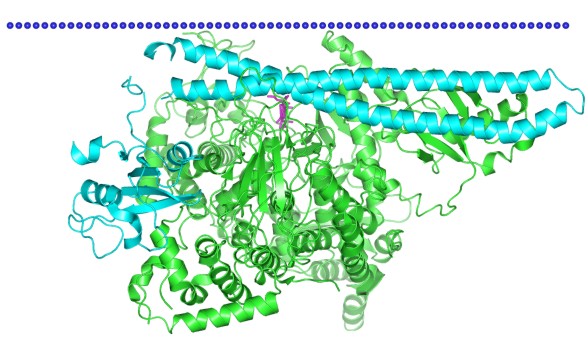Mempro™ Phosphatidylinositol 3-/4-Kinase Production Using Virus-Like Particles
Creative Biostructure can provide custom Mempro™ phosphatidylinositol 3-/4-kinase production services using virus-like particles (VLPs).
Phosphatidylinositol (PI) metabolism plays a crucial role in various cellular functions in both animals and higher plants, including control of cell growth, regulation of cell cycle progression, a DNA damage checkpoint, recombination, and maintenance of telomere length. Phosphatidylinositol 3-kinase (PI3-kinase) is an enzyme that can phosphorylate phosphoinositides on the 3-hydroxyl group of the inositol ring and function as secondary messengers in cell signaling. While phosphatidylinositol 4-kinase (PI4-kinase) is an enzyme that can act on PI in the first committed step in the production of the secondary messenger inositol-1'4'5'-trisphosphate. It is shown that PI 3-/4-kinases share a conserved catalytic domain at their C-terminal section.

Figure 1. The structure of PI-4,5-bisphosphate 3-kinase catalytic subunit, an alpha isoform. (OPM database)
VLPs are self-assembled multisubunit protein structures, which can mimic the native virus, but are non-infectious due to lacking any viral genetic information. VLPs derived from the Hepatitis B virus and consisted of the small HBV derived surface antigen (HBsAg). In addition, VLPs carrying native-conformation membrane proteins (termed lipoparticles) have been employed for the production of integral membrane protein. Lipoparticles can incorporate a wide range of structurally intact membrane proteins, including G protein-coupled receptors (GPCRs), and ion channels.
Creative Biostructure can provide high-yield PI 3-/4-kinases in the stable, highly purified and native-conformation state. Lipoparticles can be generated from bacterial cells, yeast cells, insect cells, plant cells and mammalian cells for PI 3-/4-kinase production. Escherichia coli (E. coli) strains and insect cells are the most widely used systems for VLPs production. Mammalian cells are also widely used for VLPs production with the target to construct vaccine candidates and gene therapy agents. For instance, lipoparticles can be obtained from mammalian cells by co-expressing the retroviral structural core polyprotein, Gag, along with the membrane protein of interest. Gag core proteins self-assemble at the plasma membrane, where they bud off and capture target membrane proteins. Since the PI 3-/4-kinases within lipoparticles are derived directly from the cell surface without mechanical disruption or detergents, the native structure and orientation of PI 3-/4-kinases are retained.
Creative Biostructure provides other various Mempro™ membrane protein production services. Please feel free to contact us for a detailed quote.
References:
A. Roldão, et al. (2010). Virus-like particles in vaccine development. Expert Rev. Vaccines, 9(10): 1149-1176.
D. P. Patterson, et al. (2012). Virus-like particle nanoreactors: programmed encapsulation of the thermostable CelB glycosidase inside the P22 capsid. Soft Matter, 8: 10158-10166.
J. Y. Jung, et al. (2002). Phosphatidylinositol 3- and 4-phosphate are required for normal stomatal movements. Plant Cell., 14(10): 2399-2412.
M. Fujimoto, et al. (2015). Phosphatidylinositol 3-kinase and 4-kinase have distinct roles in intracellular trafficking of cellulose synthase complexes in Arabidopsis thaliana. Plant Cell Physiol., 56(2): 287-298.
S. Willis, et al. (2008). Virus-like particles as quantitative probes of membrane protein interactions. Biochemistry, 47(27): 6988-6890.